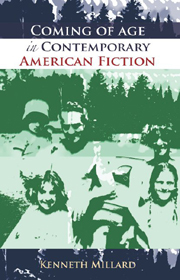Book contents
- Frontmatter
- Contents
- Acknowledgements
- Introduction: Contemporary Coming of Age – Subject to Change
- 1 In the Name of the Father
- 2 I Change Therefore I Am: Growing up in the Sixties
- 3 Citation and Resuscitation
- 4 Language Acquisition: Life Sentences
- 5 Lexicon of Love
- 6 Memoirs and Memorials
- Conclusion
- Bibliography
- Index
Introduction: Contemporary Coming of Age – Subject to Change
Published online by Cambridge University Press: 12 September 2012
- Frontmatter
- Contents
- Acknowledgements
- Introduction: Contemporary Coming of Age – Subject to Change
- 1 In the Name of the Father
- 2 I Change Therefore I Am: Growing up in the Sixties
- 3 Citation and Resuscitation
- 4 Language Acquisition: Life Sentences
- 5 Lexicon of Love
- 6 Memoirs and Memorials
- Conclusion
- Bibliography
- Index
Summary
‘The youth of America is their oldest tradition’
– Oscar WildeThis book is a critical study of coming of age as it is represented in the contemporary fiction of the United States. It is a work of advocacy on behalf of the individual novels that are included for detailed interpretation, and simultaneously, an extended argument about the significance of coming of age to our understanding of contemporary America. Adolescents are important because of the ways in which they are at the forefront of social change, even while they are simultaneously the products of an adult social culture that shapes their development. This is a dynamic relationship between the individual and society, and it has some parallels in the study of literature. The individual novel is conditioned by those traditions and conventions that it draws upon to constitute itself as a novel in the first place. But, at the same time, our understanding of those conventions is changed, however subtly, by each individual novel that interprets them for is own unique creative purposes. This brings us immediately to the issue of genre, which is particularly germane to the study of adolescence. Some knowledge of genre theory is invaluable as a guide to how adolescence in the novel might be approached. Recognising an individual work's relation to its proper genre is often fundamentally important to the act of interpretation, because it is a means to approach a text that enables us to identify important aspects of its meaning: ‘The function of genre conventions is essentially to establish a contract between writer and reader so as to make certain relevant expectations operative, and thus to permit both compliance with and deviation from accepted modes of intelligibility’ (Culler 1975: 147).
- Type
- Chapter
- Information
- Coming of Age in Contemporary American Fiction , pp. 1 - 14Publisher: Edinburgh University PressPrint publication year: 2007



